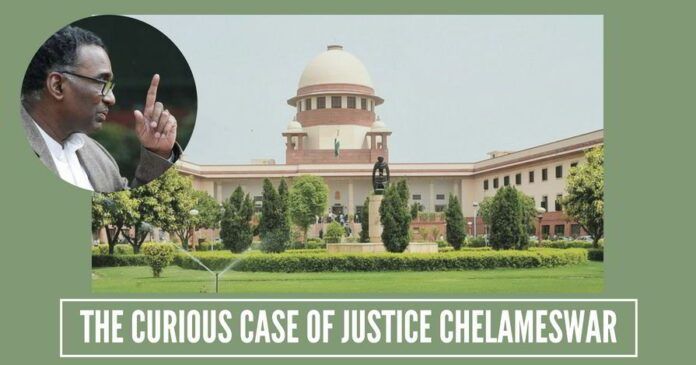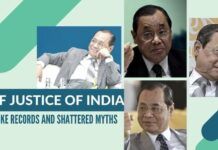
Justice Chelameswar and three of his fellow judges had hurriedly convened a press conference in New Delhi to “inform the nation” about ‘happenings’ within the Supreme Court of India.
The Supreme Court of India in its recent judgment on a public interest litigation (PIL) filed by Shanti Bhushan (TOI July 7th, 2018), has reiterated, for the third time in eight months that the Chief Justice of India (CJI) will have sole authority on allocating cases in the top court. The judgment although pertains to the internal administration of the Apex Court, has huge implications, particularly with regards to the powers of the CJI. The judgment also firmly puts to rest the unseemly controversy raised by Justice Chelameswar and three other judges in their well-publicized press conference in January 2018.
The anguish of the four judges was over the CJI’s powers to allocate cases to his subordinate judges.
It may be recalled that Mr.Chelameswar and three of his fellow judges had hurriedly convened a press conference in New Delhi to “inform the nation” about ‘happenings’ within the Supreme Court of India. A startled nation watched the drama unfold, hoping to hear some radical steps to reform the judiciary or something to that effect. Instead, the justices raised the banner of revolt. It turned out, much to the disappointment of millions of Indians, to be another case of washing dirty linen in public.
The anguish of the four judges was over the CJI’s powers to allocate cases to his subordinate judges. An eager opposition jumped onto this ‘rebellion’ that ultimately led to the tabling of the motion for the impeachment of the CJI in Parliament. That the motion was rightfully defeated is not the issue here. It certainly opened the doors to the ‘happenings’ within the Supreme Court. This power play or the quest for control over judge’s caseload unabashedly played out in front of the nation, masquerading as concern for the ‘functioning’ of the highest judicial body of the land.
The press conference of Justice Chelameswar et al. or the failed move to impeach the Chief Justice cannot be a surprise if one looks into what is happening within this high judicial body. That Justice Chelameswar later met with a communist leader and other opposition politicians and the likes of Shanti Bhushan had filed a follow-up PIL to wrest control of the muster from the CJI speaks volumes for itself.
The said judges seem to be so oblivious of the humungous challenges and problems faced by the courts in the country is indeed hurting. It certainly shows that a section in the judiciary has consistently put personal career aspirations over and above the sacred function of delivering justice. No one can fault them for personal ambitions, but to cloak it as a concern for the judiciary does not lend them dignity at all.
The huge backlog of cases also indirectly impacts the daily life as well as the long-term economic well-being of the country.
In this context, it is worth looking at the problems and challenges confounding the judiciary in India today. Take a look at the data presented by National Judicial Data Grid (NJDG). According to the NJDG, the backlog of cases in the judicial system in India was approximately 3.3 crores including 43 lakh cases in High Courts and 58,000 cases in the Supreme Court. (Business Today, June 28, 2018). In a related news report (The Pioneer 24th November 2017), it was pointed out that almost two thirds or 67% of the prisoners in Indian jails are under-trials. This is indeed shocking.
But amidst all the pendency, ironically, the Supreme Court did find time to convene, in the middle of the night, to pass its considered views on the election outcome and the Governor’s decision to give two weeks’ time for the BJP to prove its majority in the recently concluded elections in Karnataka. The apex court, it appears can definitely find time and resources to hear cases of the mighty and powerful almost immediately while the average citizen may have to wait for years, if not decades to get justice.
I have not heard any statement or action plans to solve this heart-rending problem of pending cases from Justice Chelameswar or his brother judges. Maybe I missed it. But their silence on the real problems of the judiciary is indeed deafening.
The huge backlog of cases also indirectly impacts the daily life as well as the long-term economic well-being of the country. For example, litigations relating to land acquisition delays new road and rail infrastructure. Putting corrupt politicians in jail too is impacted by these backlogs. It can thus be argued that the inefficiencies in the delivery of justice and other judicial services in India have contributed a great deal, albeit indirectly, to its economic backwardness.
To trade Supreme Court’s stature and importance for few minutes of the national spotlight on television or media is nonetheless a sacrilege that most ordinary Indians cannot easily countenance.
Needless to say, the impact of the backlog of cases in India is huge and often not easily quantifiable and has the potential of even destroying the country’s democratic framework. Hence the need of the hour is a collective effort from all three branches of government – legislature, executive, and the judiciary to quickly clear the backlog of cases. The government’s Digital India and other initiatives to use technology to enhance delivery of services is something the judiciary can learn from.
In this context, it must be reminded that the Supreme Court is not just made up of its CJI and the other justices who sit on its benches. Many numbers of eminent judges have occupied its high offices as judges and Chief Justices. But as an institution, it is larger than all of them – the current and past incumbents put together. In fact, it stands tall as the last and final beacon of hope in a democracy and India is no exception.
To trade its stature and importance for few minutes of the national spotlight on television or media is nonetheless a sacrilege that most ordinary Indians cannot easily countenance. For them, the career fortunes of individual opportunistic judges are of no consequence when crores of cases are pending and every day unknown numbers of lives are lost or wither away in prisons just because justice could not be delivered on time. If this is not rank opportunism, what else could be? Any amount of tall talk and no action will not cut ice in a resurgent India we are witnessing today. The writing on the wall is clear.
Note:
1. Text in Blue points to additional data on the topic.
2. The views expressed here are those of the author and do not necessarily represent or reflect the views of PGurus.
- The dossier debacle – Pakistan in the doghouse - December 3, 2020
- Economic impact of COVID-19 – The hard lessons - May 25, 2020
- Will Financial Inclusion make India a US$5 trillion economy? - July 16, 2019











As master of the roster why haven’t the CJI failed to prioritize the most critical cases to be dealt with in the supreme court?; on an urgent basis. We all are sure that any case that affects Modi, Amit Shah and other BJP cronies will be his last priority. That would include among others, the Loya case, prajapati-amit shah angle, VYAPAM case and all cases against the priviledged politicians and other corporate crooks. According to this author, since the 4 judges exposed the decaying filth covered under the rug, for the whole nation to see; they are all bad. Was rewarding a retired judge with governorship in kerala for protecting Amit Shah an ethical act?